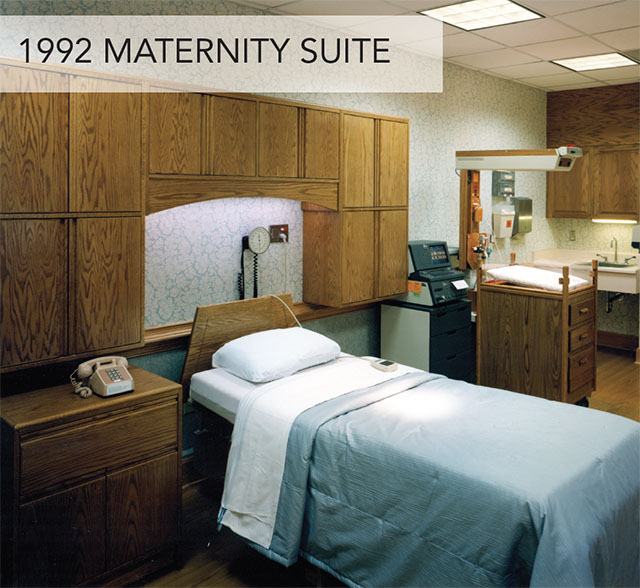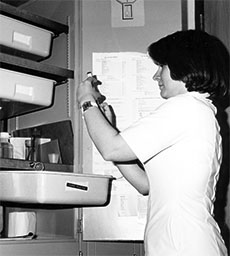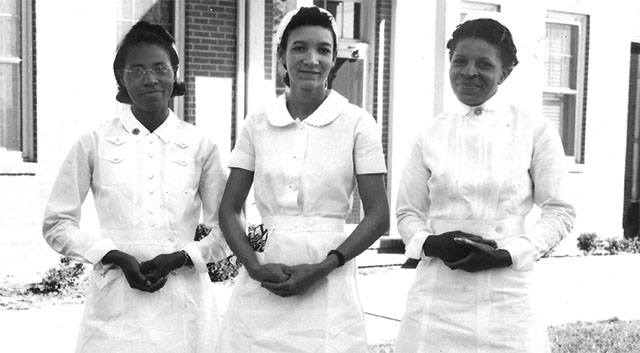|
|||
Grace Hospital - Noteworthy Moments - Part 2 - (Back to History Wall Main Page) |
|||
Friesen-Designed Grace Hospital One of First in the CarolinasThe Grace Hospital of 1973 looked vastly different from the previous hospital or any hospitals around the region. The Board of Trustees picked a “visionary, modern” design concept for its new hospital put together by Gordon Friesen. Friesen (1909-1992) has been called the pioneer of the hospital consulting industry, “one of the first to challenge previously unquestioned health care philosophies.” The new hospital was the very first “Friesen” designed hospital in the Carolinas, and one of the first in the Southeast. At the time, Grace was only the 65th hospital with this design.
“The Friesen system goes back to the late 1950s, so it’s not entirely new. But it’s a new concept to use because it’s the first one in the Carolinas,” said Pete Roye, assistant administrator in 1973 during a newspaper interview. The new Grace Hospital cost $6.8 million. All rooms were private or semi-private, as there were no wards, and each had a toilet and shower. “But it’s the Friesen system that is the heart and soul of the effort to improve medical care for the citizens of the area,” said The News Herald in a special edition devoted to featuring the new hospital.
The concept is that supplies and material needed in the care of patients should be brought as close to the patient as possible so that nurses can remain in the patient area at all times. Frieden felt that “nurses should look after patients, not for supplies.” Friesen was noted for saying the professional nurse should be available to the patient 100 percent of the time, which means that everything the nurse needs should be in place at the bedside. “Each patient’s room, in effect, should become its own nursing station,” he said, “containing its own service area and all other accessories required for daily patient care.” The second big difference and the one most apparent to patients and visitors at the time was that the patient room became the center of activity rather than the nursing station. Pass-through cabinets in the walls of each patient room contained nearly all of the supplies nurses and medical staff need for the care and treatment of the patients in that particular room. These cabinet-like structures were known as Nurservers and were stocked by technicians from the corridor while the nurse retrieved needed items from the patient room side. “The most important thing about the system is freeing the nurse to perform her duties more efficiently,” Roye said in 1973. “The old system forces her to wait at her station.” In conventional hospitals at the time, linens, drugs, surgical instruments, office supplies, etc. had their separate and independent distribution systems from the laundry, pharmacy, central sterile supply and storeroom. In the Friesen hospital, all of these items are processed and distributed through the Sterilizing Processing Distribution (SPD). Other modern features included pneumatic tubes, pocket beepers (explained in the article as radio pagers), intercoms and cart dumbwaiters all designed to lower operating costs and therefore, less patient cost. Communications are managed through ACC – administrative communications center. Calls from various rooms can be relayed to a nurse or doctor anywhere in the building, Roye said. The pneumatic tube system is really a step saving system. The tube whisks a doctor’s prescription to the pharmacy by way of the ACC, or can simplify many of the procedures that used to keep nurses constantly on the move and away from the patient’s room. Gordon Friesen is still considered |
Moments
|
||
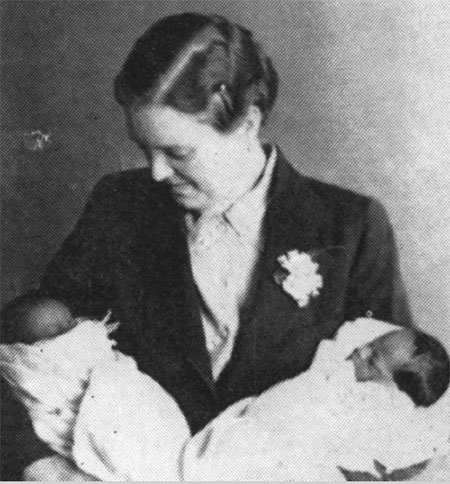 |
Miss Irene Rust, RN, with the African American twins born in 1937. Many of the nurses had their photos made with the twins. |
In the late 1930s and early 1940s, three black nurses joined the staff at various times: Laura Chambers Lattimore, RN, Ethel LaGrand Wright, RN, both from Morganton, and Tommie Alice Smith, RN, of Hickory. Miss Smith received her nursing degree in 1931 from Lincoln Hospital in Durham. A paper she wrote gives insight into the “Colored Department” in 1943.
“The Colored Department has grown from 12 beds on the first floor of the main Hospital building to a separate unit which is one of the best of its kind in the State,” she wrote. “We have seen our unit fill to capacity, even to the waiting room. We like our waiting room very much and would greatly appreciate having sufficient room for our patients without the necessity of having to use it. So widely known is our department we have had patients from Caldwell, Catawba and even Buncombe counties.”
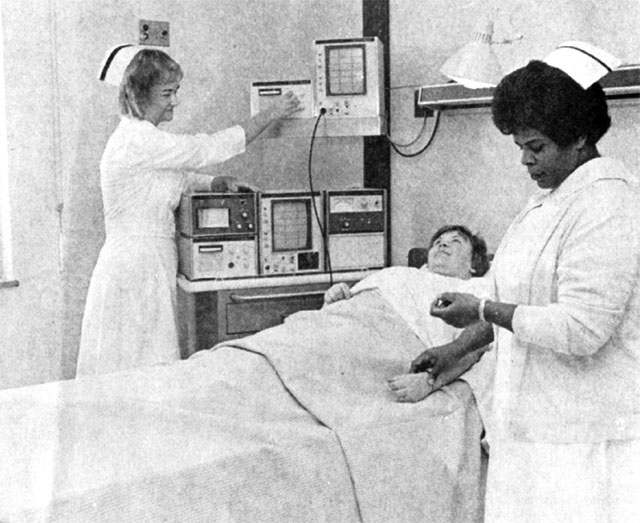
Margaret Setzer, RN, (left) and Jo Anne Harris, RN, check the progress of a patient in one of the Critical Care Unit’s six rooms in this 1973 photo from The News Herald. “New procedures are expected to greatly prolong the lives of those patients with serious heart problems or other needed intensive care,” the caption reads.
Miss Smith went on to ask administration for more registered nurses and a nursery. “We wish to see soon, and very soon, a nursery as our babies are now being kept in the wards with the mothers where they are exposed to other patients as well as visitors,” she said. “We have done our very best to make our department compare favorably with any colored hospital in the State.”
Administration later agreed and hired two more black nurses for a total of four, and constructed a nursery.
Mrs. Lattimore and Miss Wright received nursing degrees in 1934 and 1935 respectively from Saint Agnes Hospital and St. Augustine’s College in Raleigh. In 1922, the hospital was referred to as the “only well-equipped hospital for Negroes between Washington and New Orleans, serving not only North Carolina, but adjacent Virginia and South Carolina.”
Miss Wright, the daughter of Zachariah and Cornelia Chambers Wright, was Mrs. Lattimore’s niece. Miss Wright’s sister, Jo Anne Harris, also became a nurse at Grace Hospital, and was very instrumental in designing and starting the Intensive Care Unit in the Grace Hospital, built in 1973.

Janie Marie Carlton, RN, is shown here in the late 1960s with two unidentified African American patients.
Continuing its history of caring for everyone, Grace Hospital was also one of the first to offer insurance to the black community. For seven years, the hospital carried a reduced rate hospitalization plan. “At the time that the Hospital undertook to provide this service, Negroes could not get hospitalization contracts as individuals through any of the associations writing such contracts in this state,” according to the 1946 annual report.
The insurance was only good if persons were treated at Grace Hospital. In 1946 however, the board reported that Grace was getting out of the insurance business, but had found a company to offer coverage to the black community. The advantage pointed out by the board is this insurance, a precursor to BlueCross BlueShield, would be good in most hospitals in the state and “under certain conditions, most hospitals in the U.S.”
Grace Hospital remains true to its roots more than 110 years later. The hospital treats everyone and turns away no one for lack of insurance. In 2014, the hospital’s cost for treating charity care patients was $5.7 million.
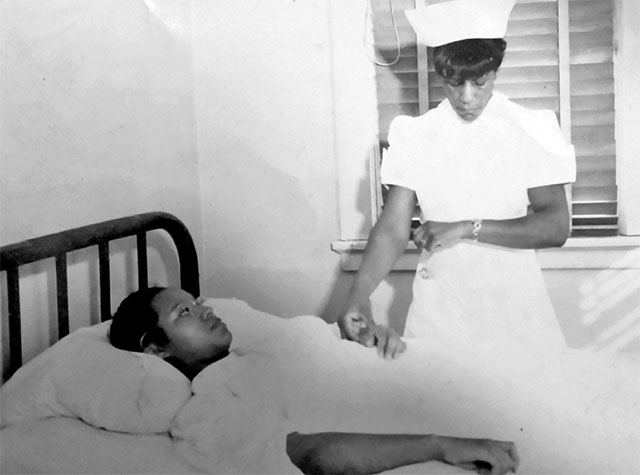
Laura Lattimore, RN, checks a patient’s vital signs in this photo from 1948.
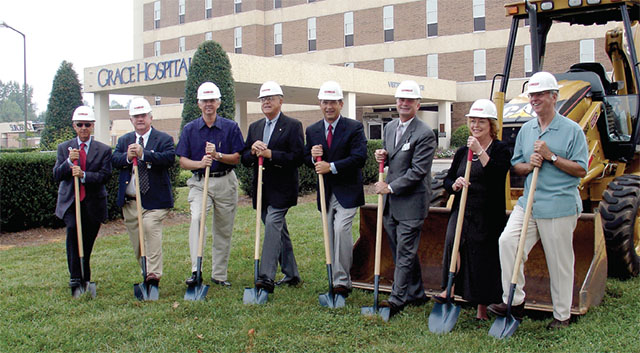
Grace Hospital officials get ready to break ground in 2005 for the largest expansion yet in Grace’s history. President and CEO Ken Wood is shown at the left along with Board Chairman Jim Hatley, other hospital officials and Carolinas HealthCare System representatives.
Largest Expansion Ever Starts in 2005
In September 2005, Grace Hospital began its largest expansion ever. Blue Ridge HealthCare held a groundbreaking that month to kick off a $100 million construction and renovation project that not only encompassed Grace, but Valdese Hospital as well.
The projects involved nearly 100,000 square feet of new construction at the two hospitals and extensive renovations over the next five to seven years. The projects, which required state approval, were the largest since the construction of either hospital.
“Our ultimate goal is to make Burke and surrounding counties a healthier place to live, work and play for this generation and for those to come,” said Kenneth W. Wood, then president and CEO of Blue Ridge HealthCare. “The plan will also put both hospitals in sync with healthcare’s increasing shift to same-day care through new, outpatient centers, both built around easy access, comfort and convenience.”

The centerpiece of the plan at Grace Hospital included a new two-story outpatient center stretching across the facade of the hospitals. Most outpatient services are located along this corridor known as a “medical mall.”
The center includes a Women’s Diagnostic Center, non-invasive cardiology, a new main lobby and new dining area, among other features.
A two-story 500-space parking deck guides visitors to the new main entrance. To place parking “on grade” with entrances to the new outpatient center, more than 50,000 cubic yards (almost 70,000 tons) of earth were removed from the existing hill at the main entrance.
“We’re still taking care of the people of Burke County,” said Alfred Hamer, MD, whose family moved here in 1939 when his father began practice at Grace. “I can remember the hospital as it was in 1939 and how it evolved into the new hospital we have today.”

Dr. Hamer, who began practice at Grace himself in 1965, pointed out that the new construction will mean yet another first-rate facility. “Over the years it’s just gotten
better,” he said.
From the four-story brick structure on College Street that had 120 beds to the two-story Friesen designed hospital with 161 acute care beds, today’s Grace Hospital is licensed for 204 beds and cares for almost 7,000 inpatients a year and more than
35,000 Emergency Department patients.
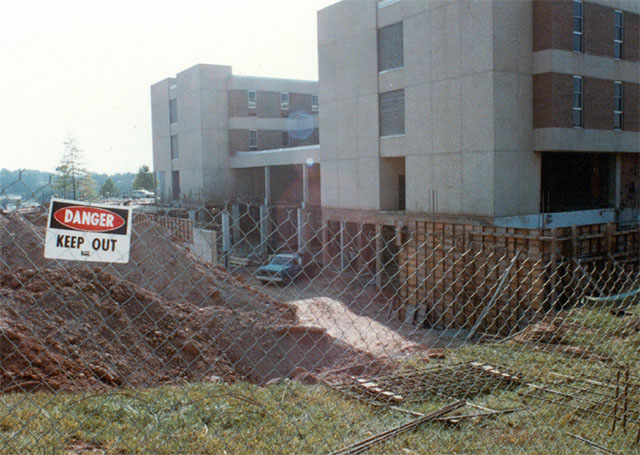
TWO FLOORS ADDED - Less than 10 years after construction of the “new” Grace, the hospital board decided to expand again. This time, the $13.6 million project added the upper two floors to the existing hospital turning all semi-private rooms into private ones. The project also called for the creation of a new entrance for the emergency room, patient admission and out-patient registration. Hospital officials said this construction would allow Grace to completely separate its in-patient and out-patient facilities making it less confusing and less crowded in each area. Additionally, the new and renovated space created room for an improved and expanded clinical laboratory, X-ray, physical therapy, respiratory therapy and out-patient surgery. “Grace Hospital is preparing for future needs and technological advances that will occur in the future,” said Christopher Johnston, administrator. “As much as one-third of all procedures are now done on an out-patient basis, and as much pre-admission testing as possible is done prior to entry, thus creating a shorter stay for the patient.”
“You may not recognize the Grace Hospital of the next decade or beyond but be assured that it will remain true to the legacy begun by the Hughsons, Miss Allen and Dr. Phifer,” Wood said. “Their tireless service and commitment will serve as our guide through the next 100 years and beyond.”
The Campus Redevelopment Plan, in planning stages for three years, supported the goals of addressing the community’s major health issues: heart disease, cancer, women’s and children’s health, digestive diseases and bone and joint diseases.

The construction project also focused on creating convenient, efficient facilities that are patient-focused and physician-friendly; meeting the increasing shift toward providing healthcare in the outpatient setting; upgrading inpatient facilities at both hospitals; and improving and modernizing basic internal systems at both hospitals such as heating and air conditioning and electrical.
Funding the construction came through a combination of bonds, investment income and revenues. And just like in the past, the people of Burke County supported the construction effort. “We have been especially encouraged by the community’s support,” Wood said at the time.
“Individual citizens in Burke County were among the largest purchasers of the bonds when they went on the market. That portion of the bond issue sold out in less than eight hours.”
